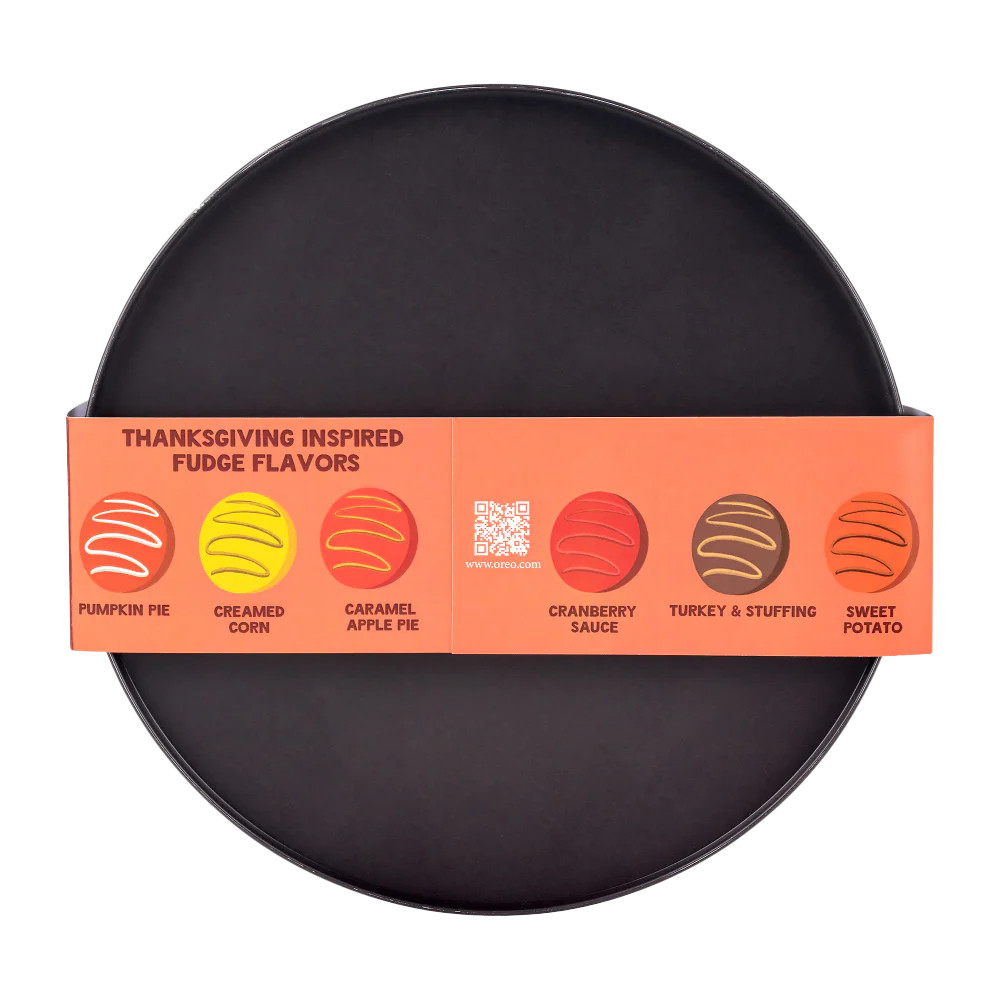Jon Seager, VP of Engineering, talks exclusively to The RegUbuntu Summit The Register FOSS desk sat down with Canonical’s vice-president for engineering, Jon Seager, during Ubuntu Summit earlier this month. This is a heavily condensed version of our conversation.…
Budget-Friendly Mac Mini Alternative, This Windows 11 Pro Mini PC Selling for Peanuts at Amazon

Acemagic mini PC delivers Mac Mini alternative at one-third the price.
The post Budget-Friendly Mac Mini Alternative, This Windows 11 Pro Mini PC Selling for Peanuts at Amazon appeared first on Kotaku.
Intel Preparing Linux Graphics Driver For Xe3P DisplayPort 2.1 ALPM Support
Last month Intel’s open-source Linux software engineers began sending out Xe3P_LPD display support in preparation for display capabilities with Nova Lake. Now being built out atop that is further functionality with the most recent talking point being DisplayPort 2.1 Advanced Link Power Management (ALPM)…
Spotify Sued Over ‘Billions’ of Fraudulent Drake Streams
A new class-action lawsuit accuses Spotify of allowing billions of fraudulent Drake streams generated by bots between 2022 and 2025, allegedly inflating his royalties at the expense of other artists. “Spotify pays streaming royalties using a ‘pro-rata’ model based on an artist’s market share,” notes Consequence. “Each month, revenue from subscriptions and ads is collected into a single, fixed ‘pot’ of money, which is then distributed to rights holders based on their percentage of the platform’s total streams. Because this pot is fixed, an artist who artificially inflates their numbers through bots would dilute the value of every legitimate stream. This allows them to take a larger share of the pot than they earned, effectively siphoning royalties that should have gone to other artists.” From the report: According to Rolling Stone, the lawsuit alleges bot use is a widespread problem on Spotify. However, Drake is the only example named, based on “voluminous information” which the company “knows or should know” that proves a “substantial, non-trivial percentage” of his approximately 37 billion streams were “inauthentic and appeared to be the work of a sprawling network of Bot Accounts.”
The complaint claims this alleged fraudulent activity took place between “January 2022 and September 2025,” with an examination of “abnormal VPN usage” revealing at least 250,000 streams of Drake’s song “No Face” during a four-day period in 2024 were actually from Turkey “but were falsely geomapped through the coordinated use of VPNs to the United Kingdom in [an] attempt to obscure their origins.” Other notable allegations in the lawsuit are that “a large percentage” of accounts were concentrated in areas where the population could not support such a high volume of streams, including those with “zero residential addresses.” The suit also points to “significant and irregular uptick months” for Drake’s songs long after their release, as well as a “slower and less dramatic” downtick in streams compared to other artists.
Noting a “staggering and irregular” streaming of Drake’s music by individuals, the suit also claims there are a “massive amount of accounts” listening to his songs “23 hours a day.” Less than 2% of those users account for “roughly 15 percent” of his streams. “Drake’s music accumulated far higher total streams compared to other highly streamed artists, even though those artists had far more ‘users’ than Drake,” the lawsuit concludes.
Read more of this story at Slashdot.
HP 17-Inch Laptop with Ryzen 5 Nearly Free (71% Off), Amazon Clearing Stock for Early Black Friday

HP 17-inch laptop with 64GB RAM drops to $1,029 and saves you $2,500 instantly.
The post HP 17-Inch Laptop with Ryzen 5 Nearly Free (71% Off), Amazon Clearing Stock for Early Black Friday appeared first on Kotaku.
TikTok announces its first-ever awards show in the US
TikTok just announced that it will be hosting its first-ever awards show in the US. The appropriately-named TikTok Awards will take place on December 18, starting at 9PM ET. It’s a live event that will be held at the Hollywood Palladium in Los Angeles. Of course, it’ll be livestreamed on TikTok. The platform Tubi will begin streaming the event on the next day.
Awards will include stuff like “Creator of the Year” and “Video of the Year.” There will also be awards given for “Breakthrough Artist of the Year” and “Muse of the Year.” I’m not sure what that last one means, but Paris Hilton grabbed a nomination for some reason.
Most nominees are influencers of some sort. There are no traditional journalists in the mix, likely because the entire event seems to be apolitical. One of the clips nominated for “Video of the Year” features a fashion influencer holding up some unique finds. Another is a recipe for “Homemade Dubai Chocolate” that did make me pretty hungry, so there’s that.
KATSEYE, sombr, Laufey & More Vie for Breakthrough of the Year at First-Ever TikTok Awards: Nominations Announcedhttps://t.co/cpYWvrMVHv
— billboard (@billboard) November 3, 2025
Users will be able to vote for their favorite creators beginning on November 18. TikTok is launching a voting portal that’ll be available on the platform.
The ceremony itself has all the trappings of a gala event. There’s a red carpet, live performances, a live audience and more. This is in direct contrast to the recently-announced Instagram Ring awards. There’s no live event for that one and the awards will be sent in the mail.
Introducing Rings: an award from Instagram that’s all about celebrating those who aren’t afraid to take creative chances and do it their way. pic.twitter.com/fnRgq0j51i
— Instagram (@instagram) October 6, 2025
TikTok is no stranger to awards shows. It just hasn’t been hosting them in the US. The social media app has created similar events in Germany, Mexico, Korea and other locations in the past several years.
This article originally appeared on Engadget at https://www.engadget.com/social-media/tiktok-announces-its-first-ever-awards-show-in-the-us-183711867.html?src=rss
Waymo is launching in three new cities next year
Waymo has announced the launch of its robotaxi services in three new cities. San Diego, Las Vegas and Detroit will play home to the driverless cars as the company continues its aggressive expansion.
In a series of blog posts, the Alphabet subsidiary said Detroit residents can expect to “soon” see Waymo vehicles on the streets, mapping out the service areas before launching to the public. Timing for San Diego was more vague, with “plans to begin serving the city next year.”
Waymo’s service area in Las Vegas will include the Strip, with plans to expand to the airport “eventually.” The company currently operates in Los Angeles, Phoenix, San Francisco, Atlanta and Austin. It also recently announced expansion to Miami and Washington, DC.
Waymo also has its sights set on international expansion with a planned London launch next spring. This comes as the UK’s Automated Vehicles Act of 2024 begins to take effect, allowing autonomous vehicles to operate in the country for the first time. The company also recently announced it would be partnering with DoorDash to conduct food deliveries in Phoenix.
The autonomous taxi market has been heating up lately with Tesla’s Robotaxi expanding in Austin and San Francisco. Uber and Lucid will also be launching an autonomous taxi partnership in the Bay Area next year using the automaker’s Lucid Gravity SUV.
This article originally appeared on Engadget at https://www.engadget.com/transportation/waymo-is-launching-in-three-new-cities-next-year-182515034.html?src=rss
Google removes AI model after it allegedly accused a senator of sexual assault
Google has pulled the AI model Gemma from its Studio platform after a Republican senator said it “fabricated serious criminal allegations” against her, as reported by The Verge. Senator Marsha Blackburn (R-TN) sent a letter to CEO Sundar Pichai to accuse the company of defamation after the model allegedly created a story about her committing sexual assault.
The model was reportedly asked if Blackburn had ever “been accused of rape” and it reportedly answered in the affirmative, going so far as to provide a list of fake news articles to support the accusation. The chatbot said the senator “was accused of having a sexual relationship with a state trooper” during a campaign for state senate. This officer reportedly said “she pressured him to obtain prescription drugs for her and that the relationship involved non-consensual acts.”
Gemma is available via an API and was also available via AI Studio, which is a developer tool (in fact to use it you need to attest you’re a developer). We’ve now seen reports of non-developers trying to use Gemma in AI Studio and ask it factual questions. We never intended this…
— News from Google (@NewsFromGoogle) November 1, 2025
None of this happened, of course. The chatbot said this transgression occurred during Blackburn’s 1987 campaign, but she didn’t run for state senate until 1998. She has never been accused of anything like that.
“The links lead to error pages and unrelated news articles. There has never been such an accusation, there is no such individual and there are no such news stories. This is not a harmless ‘hallucination.’ It is an act of defamation produced and distributed by a Google-owned AI model,” she wrote to Pichai.
There’s one major caveat here. The chatbot in question, Gemma, is designed for developers and not for mass market queries. There are Gemma variants for medical use, coding and more. Google says it was never meant as a consumer tool or to be used to answer factual questions. It’s still pulling the model from AI Studio to “prevent this confusion.” It’ll still be available to developers through the API.
Google has reportedly removed Gemma from its AI studio after I demanded the company take it down for smearing conservatives with manufactured criminal allegations.
Google owes the American people answers, and I will be eagerly awaiting their response to my letter. pic.twitter.com/n8ye5ZKBu1
— Sen. Marsha Blackburn (@MarshaBlackburn) November 3, 2025
Blackburn went a step further, accusing Google’s AI platform of engaging in a “consistent pattern of bias against conservative figures.” I encounter multiple hallucinations every day. Chatbots have lied about all kinds of stuff about my life and what I write about online. AI chatbots are famous for making stuff up, conservative or not. Not everything is a political witch hunt. Sometimes tech just does what tech does.
This article originally appeared on Engadget at https://www.engadget.com/ai/google-removes-ai-model-after-it-allegedly-accused-a-senator-of-sexual-assault-170235679.html?src=rss
Proton VPN’s Black Friday deal knocks 75 percent off two-year plans
A VPN subscription can make for a good holiday gift. Everyone could do with having a VPN to help protect their online activity from prying eyes (and, perhaps, access more things to watch from their favorite streaming services). It’s something useful that a gift recipient may have never realized they needed. Of course, you may be looking for a great deal on a VPN yourself, and the Black Friday discount for Proton VPN is nothing to sniff at. You can get two years of access to the VPN Plus tier of the service for $59.76, which works out to $2.49 per month.
That’s a discount of 75 percent compared with the regular price of $10 per month. Overall, you’d save $180.
Proton VPN is our pick for the best VPN overall because it checks all of the boxes it needs to. There is a free plan with unlimited data, but with that you can only connect to servers in a few countries and the connection might not be fast enough for you to watch anything from your preferred streaming service’s library in that locale. The VPN Plus tier unlocks a lot more options, such as the ability to connect to 15,000 servers across more than 120 countries and simultaneous protection for up to 15 devices.
The apps are well-designed — Proton has clients for Windows, Mac, iOS and Android — and it’s easy to find a feature or setting you’re looking for. In our testing, Proton VPN Plus had a relatively small impact on browsing speeds. Our download speeds dropped by 12 percent and uploads by 4 percent, while the global average ping remained below 300 ms (which is especially impressive if you’re connecting to a server on the other side of the planet).
Perhaps, most importantly, though, it’s Proton’s commitment to privacy that helps make its VPN an easy recommendation. There’s a no-logs policy, meaning it does not log user activity or any identifiable characteristics of devices that connect to the VPN. Proton’s servers use full-disk encryption to bolster privacy as well.
This article originally appeared on Engadget at https://www.engadget.com/deals/proton-vpns-black-friday-deal-knocks-75-percent-off-two-year-plans-153737205.html?src=rss
OpenAI signs $38 billion cloud contract with Amazon
When OpenAI announced last week the end of its drawn-out corporate restructuring, one of the freedoms the company had managed to negotiate for itself was the ability to more easily sign cloud contracts with Microsoft’s competitors. With the new agreement in place, the company waived its first right of refusal to be OpenAI’s compute provider. OpenAI is wasting no time taking advantage of that freedom.
On Monday, Amazon announced a new multi-year, $38 billion cloud partnership with OpenAI. “Starting immediately,” Amazon Web Services will provide the company with access to “thousands” of NVIDIA GB200 and GB300 GPUs for inference and training its next-generation models. Amazon expects to deploy all the capacity OpenAI has agreed to buy by the end of 2026, with the option to purchase additional capacity in 2027 and beyond. Amazon says the partnership “will help millions of users continue to get value from ChatGPT.”
Of course, the question is how OpenAI will pay for all of its cloud commitments. The Information recently reported the company was generating about $12 billion in annualized revenue. As part of just its restructuring agreement, the company agreed to spend $250 billion on Azure services from Microsoft. It also has a revenue-sharing agreement with the tech giant that will continue when and if OpenAI is able to develop artificial general intelligence.
This article originally appeared on Engadget at https://www.engadget.com/ai/openai-signs-38-billion-cloud-contract-with-amazon-151821384.html?src=rss
Google Translate now offers Gemini-assisted translations
Google has started rolling out a new version of its Translate app with a feature that allows you to create more accurate Gemini AI-assisted translations, 9to5Google reported. The feature appears as an AI model picker at the top of the app, allowing you to choose between “Fast” and “Advanced” translations. It’s appeared for some users on iOS but not Android to date, and the Advanced mode only translates between English and French, and English and Spanish.
To use the new model, simply click on the picker up top. That gives you a choice between “Fast” that “Optimizes for speed and efficiency,” and “Advanced,” that “specializes in accuracy using Gemini,” according to the dialog box.
To test this, I ran a passage from Moliere’s French language play, Le Misanthrope: “Franchement, il est bon à mettre au cabinet; Vous vous êtes réglé sur de méchants modèles, Et vos expressions ne sont point naturelles.” The result from “Fast” mode was nearly a word-for-word translation: “Frankly, he’s fit for the closet; you’ve based yourself on bad models, and your expressions are not natural.” That is not only inaccurate (it should be “Frankly, it’s fit for the toilet”) but also unclear.
Advanced mode, meanwhile, gave me an accurate take that better invoked the book’s style: “Frankly, it’s fit to be thrown in the toilet; You have based yourself on wretched models, And your expressions are not at all natural.” The standalone Gemini app in Pro mode delivered nearly the same result, while adding context about the passage and how it fits in with the rest of the play.
At the cost of some speed, Google Translate’s new Advanced model appears to offer more accurate and contextual translations. If you really need to be sure that a translation is correct, however, it might be best to check Gemini directly, as it can also offer extra context. As always, though, remember that any AI can hallucinate and produce errors.
This article originally appeared on Engadget at https://www.engadget.com/ai/google-translate-now-offers-gemini-assisted-translations-151008774.html?src=rss
Acer Predator Triton 14 AI review: A true ultraportable gaming laptop
When I review products, I try to take other perspectives and use cases into account as much as possible. I’m very aware that I’m not the target audience for every device. But once in a while I run into something that seems like it was designed specifically for me and it just hits different. With the Acer Predator Triton 14 AI, that’s pretty much the situation. While it isn’t the flashiest or most powerful gaming laptop on the market, it has pretty much everything I look for in a portable system that lets me play games on the go — and then some.
Design and display
The term ultraportable is typically reserved for more traditional thin-and-light productivity machines, but I think it definitely applies to the Triton 14 AI. At just 3.5 pounds and 0.71 inches thick, Acer’s rig is actually a touch lighter and just as thin as a Dell 14 Premium (3.7 pounds and 0.71 inches), despite featuring a much beefier GPU. And even compared to rivals like the Razer Blade 14 (3.6 pounds and 0.64 inches thick), the Triton 14 AI isn’t losing much ground there either.
Furthermore, while some gaming notebooks go overboard with edgy aesthetics and an abundance of RGB lighting, the Triton 14 AI looks refreshingly understated. Sure, it still has customizable LEDs behind the Predator logo on its lid and per-key lighting on its keyboard. But aside from that, the laptop feels like an exercise in restraint for a category that often favors excess.The other small design flourish is a pixelated Predator logo (that looks like it was made from a tiny dot matrix display) to the right of the touchpad.. I think it’s a clever touch that hints at the notebook’s gaming focus without hitting you over the head with it.
Despite its size, the Triton 14 AI also has excellent connectivity. You get two USB-C ports (one on either side), with Thunderbolt 4 support on the right while the other is used for power and USB 4 data speeds (both can be used for charging). There are also two USB-A 3.2 jacks, 3.5mm audio, a full-size HDMI 2.1 connector and even a microSD card reader. That means you can easily hook it up to an external monitor (which you really ought to have when fragging at home). Alternatively, when you’re not gaming, it can be a great mobile editing station because offloading photos and videos from a camera via microSD is a cinch.
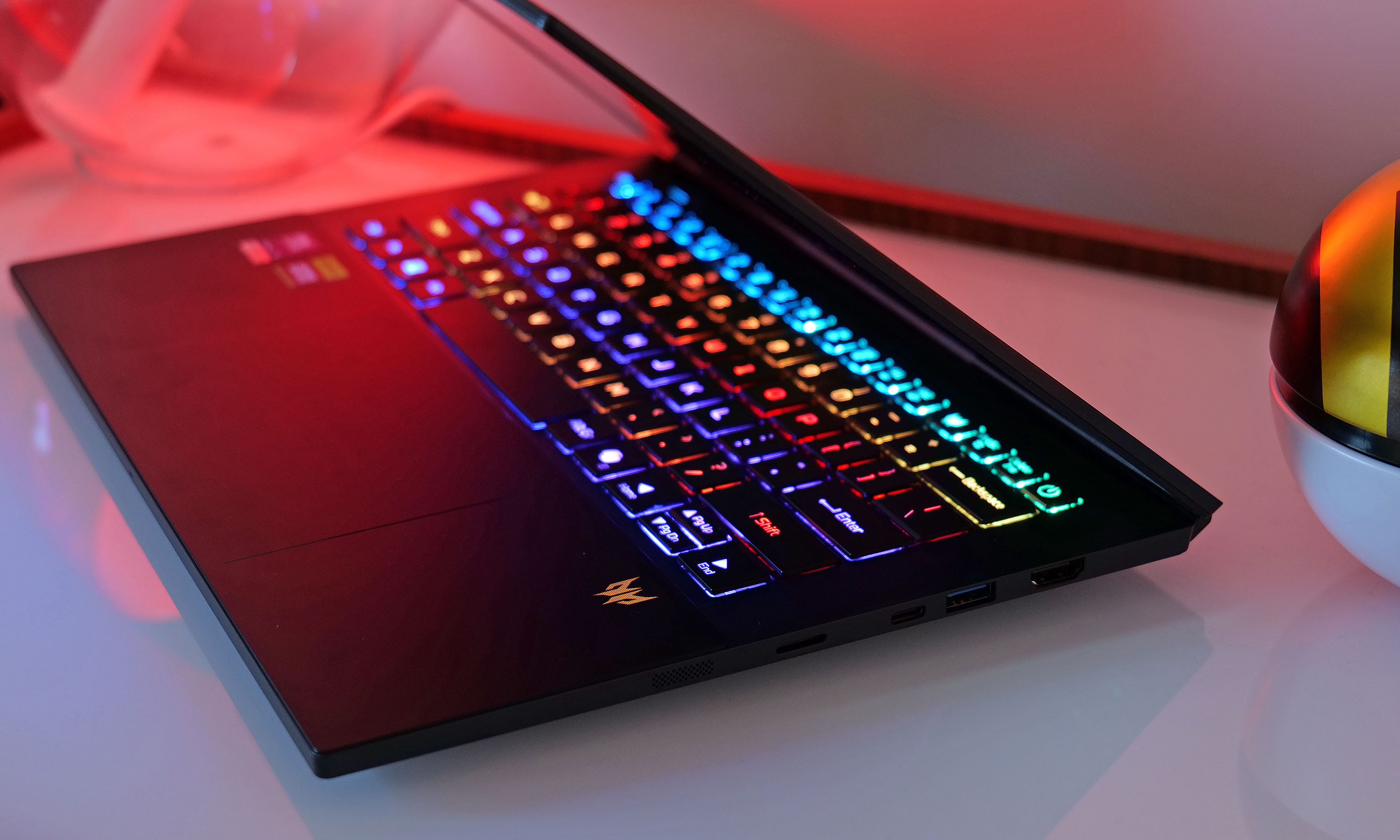
Acer didn’t cut corners with the Triton 14 AI’s display either. Sure, its 120Hz refresh rate could be a touch faster or it could have gone with a slightly higher 3.2K display like on the Dell 14 Premium, but those are real nitpicks. The OLED panel produces rich colors and in my testing, the display on my review unit actually exceeded Acer’s stated 340-nit brightness by a few percent.
While Acer included six speakers that get plenty loud, my one small gripe is that they aren’t located in the best spots to maximize audio quality. There are two drivers hidden behind tiny grilles on each edge of the laptop and four more located on the bottom. This means unless the laptop is sitting on a hard reflective surface like a desk (without something like a desk mat in between), audio often sounds muffled or dampened. It’s not a dealbreaker and I understand that the Triton 14 AI’s petite dimensions didn’t leave much room for up-firing drivers, but I wish Acer had found an arrangement that sounds slightly better.
Keyboard, touchpad and an unusual special feature

In addition to per-key lighting and a pleasantly bouncy typing experience, Acer added a few extra features to the Triton 14 AI’s mouse and keyboard that you don’t normally see on gaming laptops. On the left above the function row, there’s a physical button that makes it fast and easy to switch between various performance modes with a single press. There’s also a dedicated Predator key that acts as a shortcut to Acer’s app, where you can do things like tweak settings or adjust the laptop’s lighting.
Down below, the Triton 14 AI features a large seamless touchpad made from Gorilla Glass, similar to what you get on a Dell 14 Premium. However, to address the issue of you not knowing where the trackpad ends and the rest of the notebook’s deck begins, Acer added two light strips on either side. It’s a simple and elegant solution that looks nice too.

However, the Triton’s real party trick is that it also supports stylus input (via MPP 2.0) with 4,096 levels of pressure sensitivity. This means you can use it like a small built-in Wacom tablet. On top of that, the laptop ships with an active pen, so you don’t need to shell out extra money for one. And because Windows recognizes the stylus out of the box, there’s no extra setup required. So while this isn’t something I will use all the time, it’s nice to have for times when I feel like taking notes, sketching or just need to sign a document electronically.
Performance
Our $2,500 review unit features an Intel Core Ultra 9 CPU with 32GB of RAM and a 1TB PCIe Gen 4 SSD along with an NVIDIA RTX 5070 GPU. Notably, this is as big a graphics card as the Triton 14 AI can handle, but considering similarly-sized rivals like the Razer Blade 14 have the same limitation, it’s hard to be upset. More importantly, even without the option for an RTX 5080 or 5090, Acer’s tiny gaming laptop still boasts respectable performance.
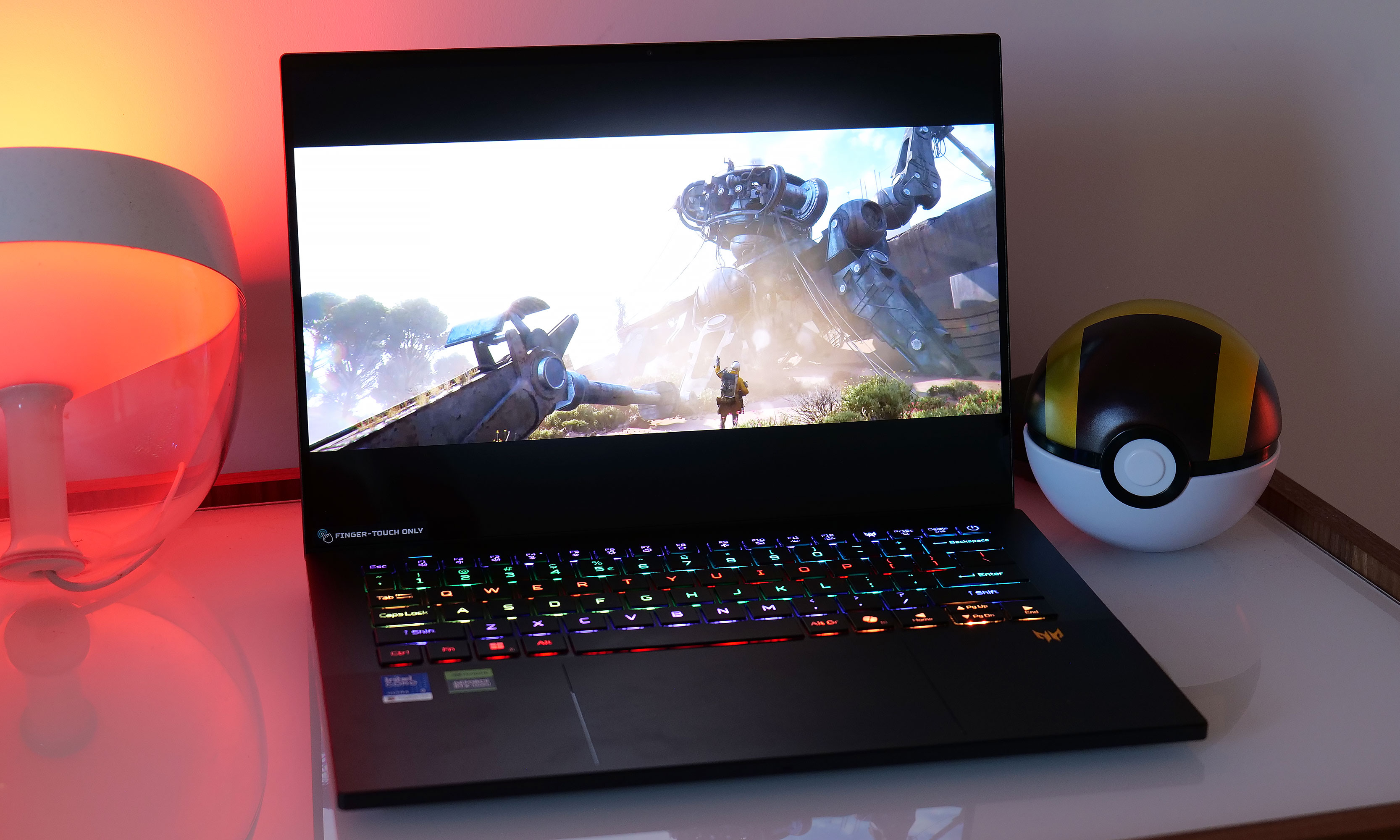
In Cyberpunk 2077 at 1080p and Ultra RT settings, the Triton 14 AI hit 55 fps, which is a notch above the 45 fps I got from the Radeon 8060S in the ROG Z Flow 13. It also means that with just a tiny bit of tweaking, it’s easy to push framerates above 60 while keeping almost all of the graphics settings maxed out. Meanwhile, in Returnal at 1080p on Epic, the Triton 14 AI fared even better, hitting 115 fps. That falls short of what I saw on the Alienware 16 Area-51 (154 fps), but considering that’s a larger system with an RTX 5080, the difference between the two machines is understandable.
As for cooling, Acer went beyond simply using a built-in vapor chamber. Instead of the paste or liquid metal used by the competition, the company says this is the first time a graphene-based thermal interface material has been used inside a gaming laptop. This makes a difference, especially on a notebook this thin, because it means for less demanding games like Teamfight Tactics, if you adjust its performance mode you can actually play them on your lap without worrying about scorching your legs. That said, you still have to watch out because there are two largish fans on the bottom as well, so for more serious titles you’ll still want to switch to a table or desk.
Battery life
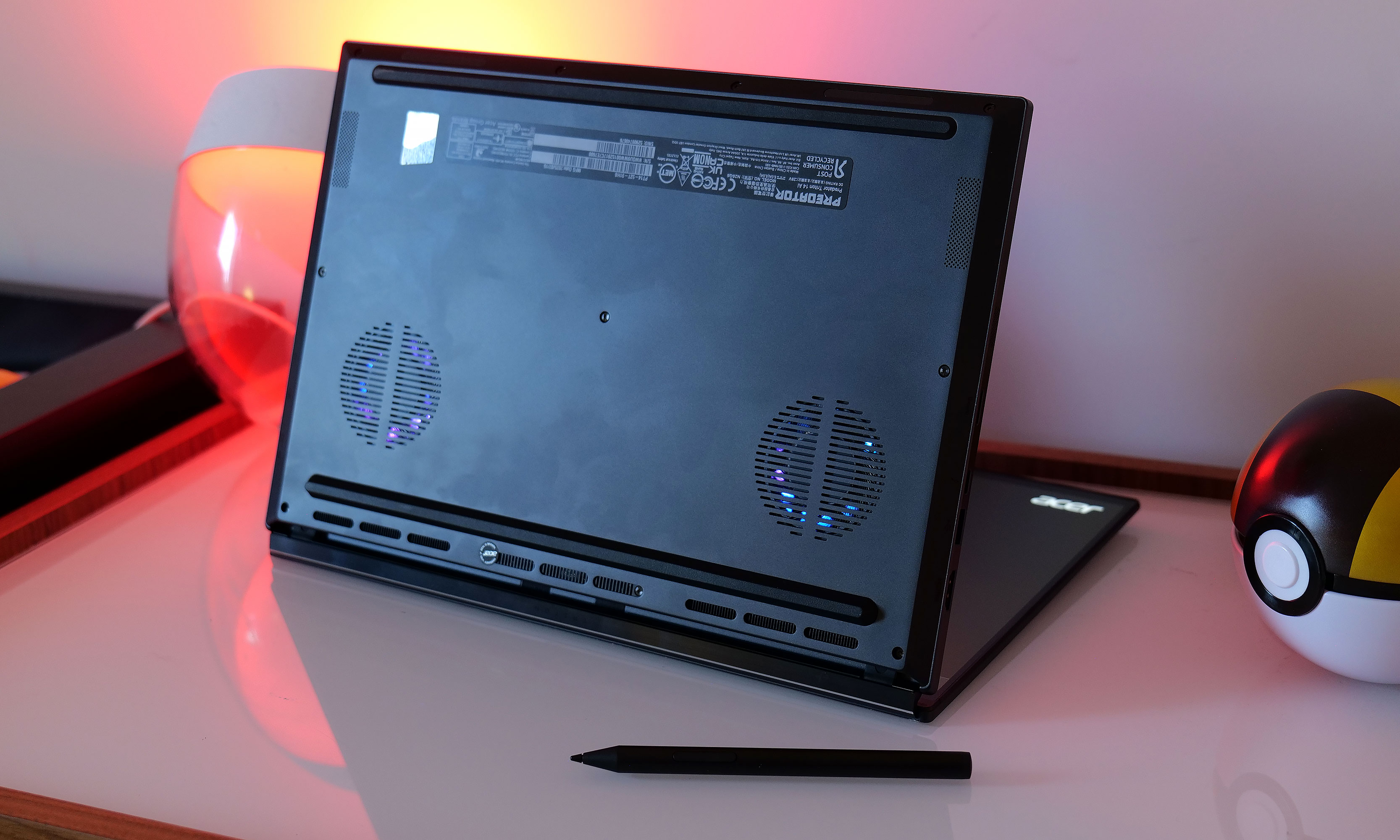
Longevity is often a concern for small, power-hungry gaming laptops like this. But somehow, Acer managed to fit a more than adequate 76Whr battery inside. On PCMark 10’s Modern Office rundown test, the Triton 14 AI lasted seven hours and 26 minutes. That’s three hours better than larger systems like the Alienware 16 Area-51 (4:13) and half an hour better than smaller rivals like the ASUS ROG Z Flow 13 (6:54). And even though it fell short by an hour when compared to a traditional ultraportable like the Dell 14 Premium (8:30), that’s still very solid when you consider the Triton’s more powerful graphics.
Wrap-up
If you’re in the market for a more powerful and sedentary type of gaming laptop that might only get moved around a couple of times a month (if that), the Triton 14 AI might not be for you. But as someone who prefers gaming laptops that are, you know, actually portable, this thing is pretty much my ideal notebook.
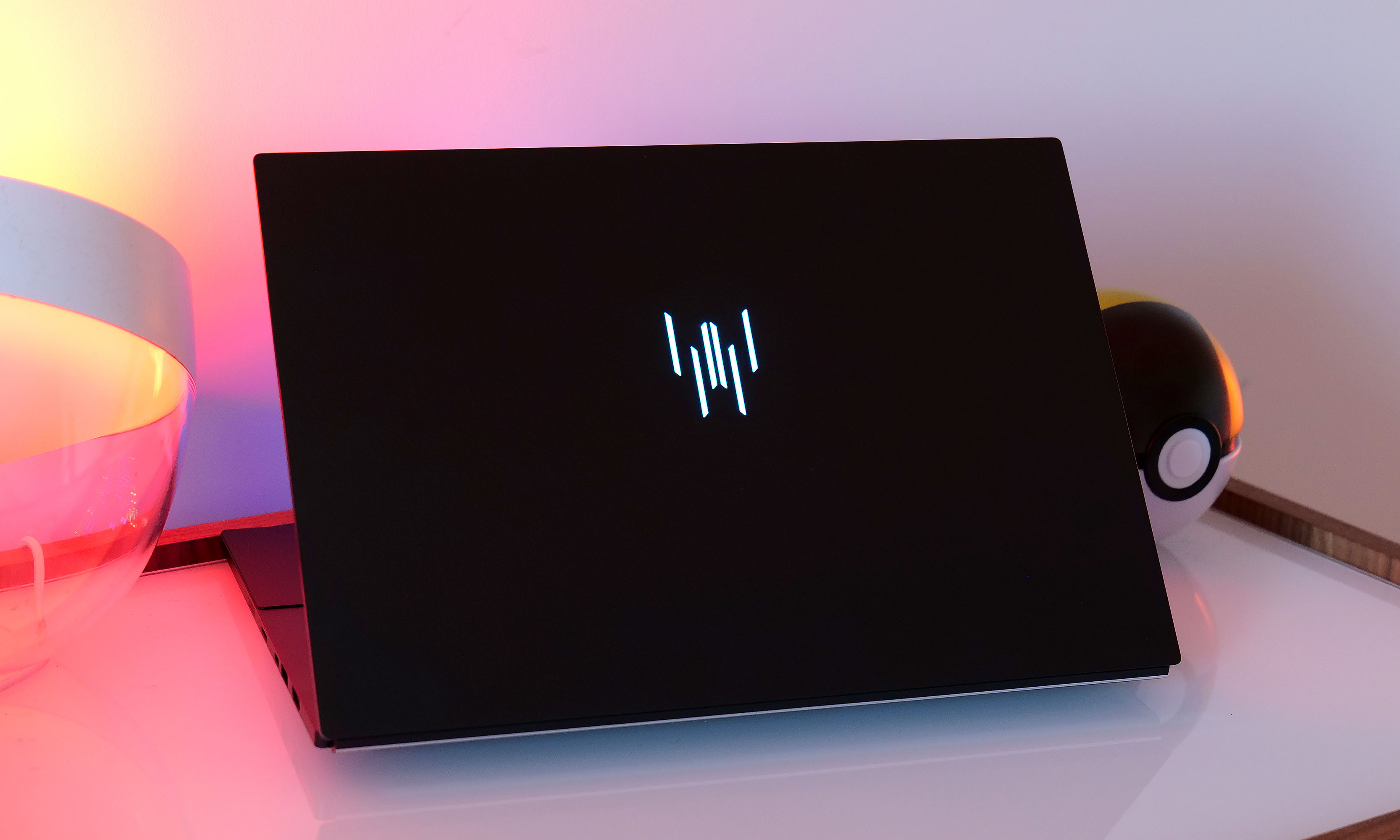
For $2,500 as tested, the Predator Triton 14 AI has a vivid OLED display, solid performance, surprisingly good battery life and an incredibly sleek chassis that begs you to take this thing everywhere. It’s a bit pricey, but considering a similarly-specced Blade 14 costs $2,700 (before sales or discounts), you might even say it’s a bit of a bargain. What puts this thing over the top though, is that Acer could have stopped there and no one would have complained. But then it added extra features like ample ports, powerful cooling and built-in stylus support (not to mention the included pen). In a lot of ways, this isn’t just a travel-friendly gaming machine, it’s a true do-everything ultraportable.
This article originally appeared on Engadget at https://www.engadget.com/computing/laptops/acer-predator-triton-14-ai-review-a-true-ultraportable-gaming-laptop-145300067.html?src=rss
Get the new Apple Watch Ultra 3 for $100 off
The era of holiday shopping is coming and there are a lot of great tech gift options for loved ones or as a treat for yourself. That includes the new Apple Watch Ultra 3, which is on sale right now for $700, down from $800.
The sale model comes with 64GB of storage, a 49mm screen and GPS and cellular service. Notably, it’s also only available with the one size, adjustable band and in two colors: a Black titanium case with Black Ocean band and a natural titanium Case with Anchor Blue Ocean band.
The Apple Watch Ultra 3 came out in early September and is one of the first smartwatches to support satellite communications. This feature means you can call, send messages or share your location with emergency services through the watch — even if you don’t have a connection. The new Ultra 3 also has a larger screen thanks to thinner bezels and a battery that can last for up to 42 hours.
If you don’t have as much cash to spend on a new wearable, or don’t need something as comprehensive as the Ultra, the latest Apple Watch SE is also on sale for $199.
This article originally appeared on Engadget at https://www.engadget.com/deals/get-the-new-apple-watch-ultra-3-for-100-off-133057973.html?src=rss
Apple Vision Pro M5 review: A better beta is still a beta
Everything new about the revamped Apple Vision Pro can fit in a single sentence: It has a far faster and more efficient M5 chip, it comes with a more comfortable Dual Knit Band and its display looks slightly sharper and faster. Beyond that, the Vision Pro is still basically a $3,500 developer kit that really isn’t meant for consumers.
Still, the Vision Pro fascinates me. It’s a bold swing from a company that’s become increasingly risk-averse over the last decade. And now that we have its first refresh, it’s clear that Apple isn’t ready to give up on the concept of spatial computing yet. For the niche audience of mixed reality developers and hardcore Apple fanatics who haven’t already picked up a Vision Pro, the new model is more compelling than the original with its aging M2 chip. If you’ve already got one, though, you can just pick up the Dual Knit Band for $99 to get a more comfortable fit.
What’s the point of the M5 Apple Vision Pro?
While the Vision Pro launched with a huge splash in 2023, it was released early last year with the 2022-era M2 chip. Now that we’re three generations beyond that Apple silicon, it’s high time it received an upgrade. With the M5 chip, the Vision Pro is up to 50 percent faster at rendering your Persona avatar and creating spatial scenes from photos, according to Apple. Both of those experiences were noticeably faster during my testing, but they also never felt too sluggish on the original Vision Pro.
As I mentioned above, having new hardware is a sign that Apple hasn’t completely forgotten about the Vision Pro. It’s not being almost immediately ignored like the original HomePod. Instead, this new model aims to fix some of the biggest annoyances from the first. The Dual Knit Band alone makes the Vision Pro feel more comfortable, since it relies on a rear and top strap to balance the device on your head. The original Solo Knit Band only had a rear strap, which clamped the Vision Pro on your head and left much of its weight resting on your forehead and nose.
While the original Vision Pro also included a Dual Loop Band in the box, that was rarely featured in the marketing for the Vision Pro, likely because it made the device appear to be more like a traditional VR headset. The new Dual Knit Band almost feels like an apology for Apple’s previous bands — it’s as if the company is admitting that it was more concerned with how the Vision Pro appeared in ads, instead of choosing a more comfortable default head strap.
In addition to making the headset feel easier to wear, the Dual Knit Band is also ingeniously simple to adjust. Twisting its small tightening knob adjusts the horizontal straps, and then you just have to pop that knob out to customize the over-head straps. That’s a major upgrade over most VR headsets, which typically rely on velcro to tighten straps over your head.
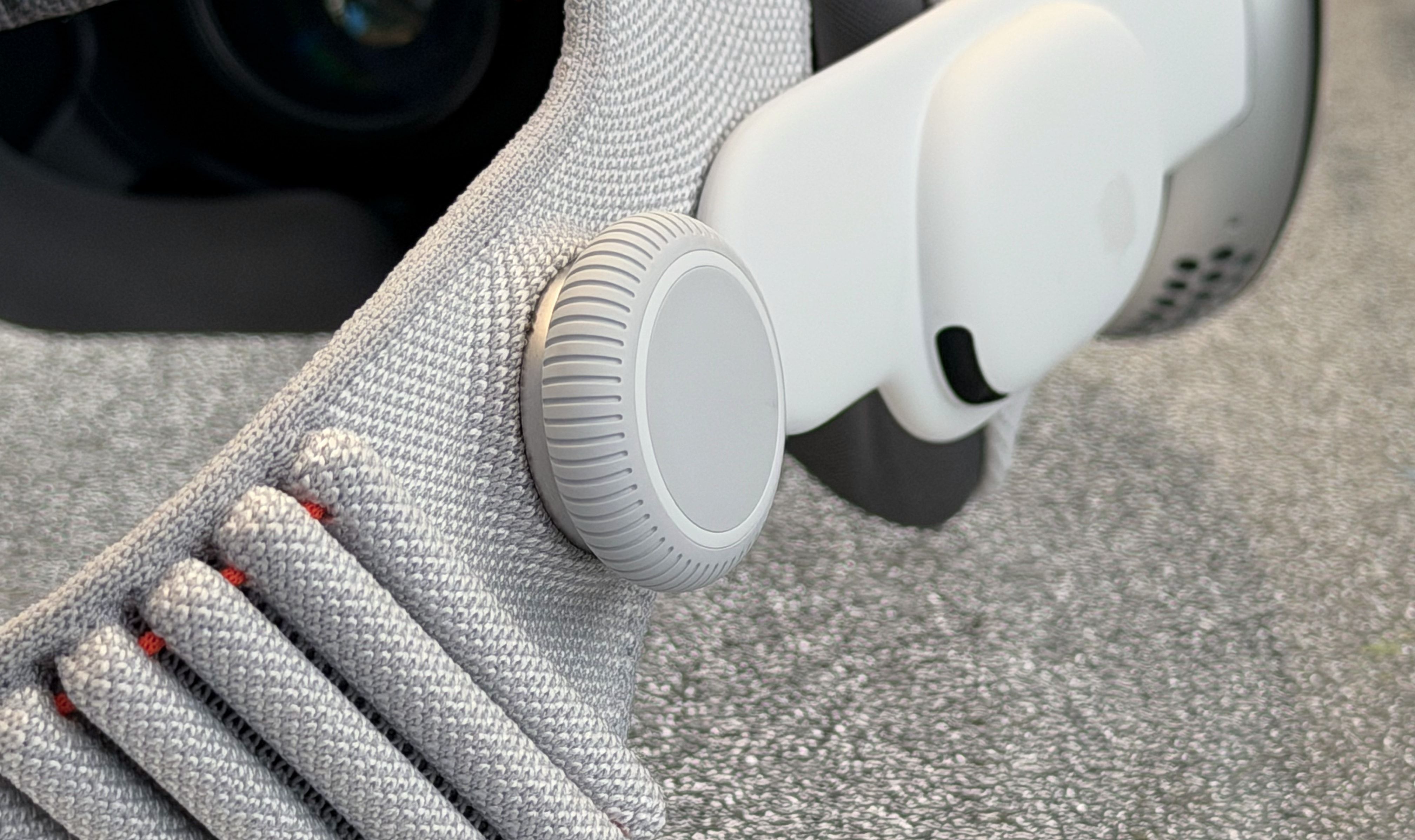
Aside from the Dual Knit Band, the Vision Pro sports the exact same design as the original model, so I’d recommend reading my initial review for more hardware specifics. “In typical Apple fashion, the Vision Pro looks far more handsome than any VR headset I’ve seen,” I wrote last year. “That mostly comes down to materials: Whereas the competition is almost entirely made of plastic cases, Apple’s device is built out of smooth glass, polished metal and designer fabrics.”
While the new Vision Pro is using the same micro OLED displays as before, the headset can render 10 percent more pixels thanks to the M5 chip. I couldn’t really see a difference when I swapped between the two headsets, but that’s to be expected with a small resolution bump. What’s more important is that the M5 Vision Pro still has some of the most impressive screens I’ve ever seen. It can scale up 4K video into enormous 300-inch windows while still looking sharp, and it’s easy to read text in the browser, or while working on a virtual Mac display.
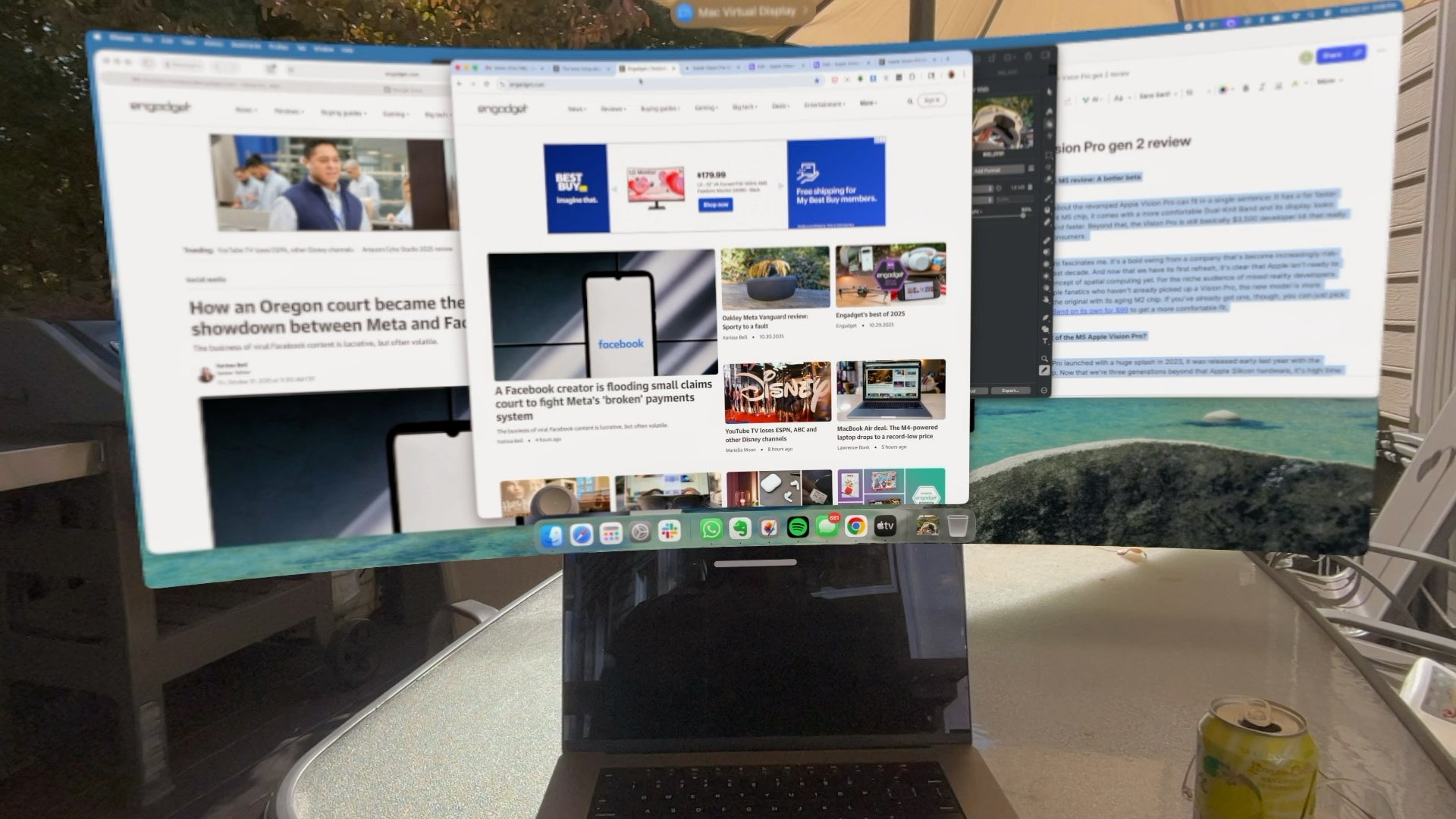
The M5 chip also allows the Vision Pro to reach up to a 120Hz refresh rate, instead of being limited to refresh rates between 90Hz and 100Hz. Again, I didn’t see a huge difference with the new model, but theoretically the higher refresh rate should allow for smoother performance while scrolling through windows and documents. It also means the Vision Pro can run games at up to 120 fps, which could be helpful if you’re trying to play Overwatch over GeForce Now streaming.
In addition to being more powerful than the M2, the M5 chip is also more efficient. I was able to use the new Vision Pro for more than two and a half hours while swapping between videos, visionOS apps and Macbook mirroring. The same workflow typically drained the original model’s battery in around two hours.

How has the Vision Pro ecosystem changed over the last year?
It’s not too often Apple has to build an entirely new operating system with fresh input mechanisms, but that’s basically what we got with visionOS. Its interface hovers in front of you, like a holographic iPad home screen. And instead of a keyboard and mouse, you interact with it mainly using finger gestures and eye tracking. I found visionOS to be surprisingly easy to use on the original Vision Pro — flicking through floating windows quickly made me feel like Tom Cruise in Minority Report — and it’s only gotten more refined over time.
For one, Apple added Spatial Personas, which are virtual avatars that can float around your space during FaceTime calls with other Vision Pro users. That feature made the headset feel like a “telepresence dream” when I first tested it out, and it’s only gotten better with visionOS 26, which has more realistic Spatial Personas. During several group FaceTime calls, I felt like I was sitting beside people in the real world, even though I was just looking at rendered faces, shoulders and hands floating in the air. The sense of true presence was uncanny: Spatial Personas can walk freely around your room, and with the flick of a button you can also collaborate together on documents, view 3D models or watch videos together in virtual space.
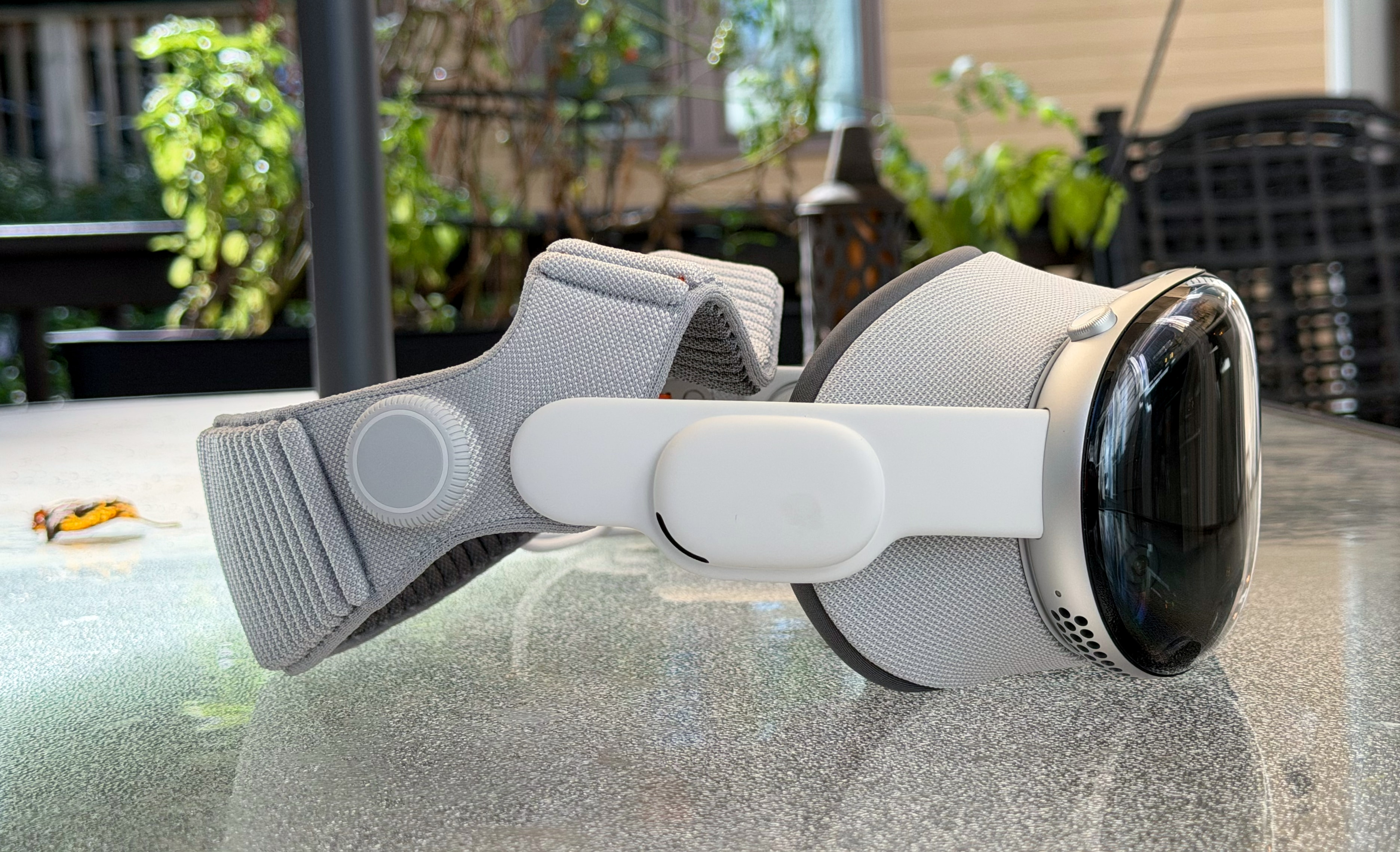
Apple’s Immersive Videos — 8K 3D 180-degree footage shot using its custom cameras — were one of the highlights of the original Vision Pro, and they still look great on the new model. I was most impressed by “Hill Climb,” an episode of the Adventure series focused on Laura Hayes, a driver attempting to make a new record racing to the top of Pikes Peak. Expansive overhead shots (which feel incredibly life-like in 3D) did a fine job of showing the scale of her drive, and footage from beside and inside her car delivered a thrilling sense of speed.
All of the Immersive Videos I’ve seen are miles ahead of the blurry, low-res 360-degree VR footage we’ve been seeing for years. Apple’s 8K 3D content is more focused on trying to recreate reality right in front of you. Looking ahead, the company also plans to broadcast live NBA games in Immersive Video and more Vision Pro content is coming from Red Bull, CNN, BBC and others.
Speaking of immersive content, Apple also added support for the PS VR2 Sense controllers in visionOS 26, which gives Vision Pro the ability to support true VR experiences. When I tried the What If?… Vision Pro experience last year, it was clear that hand gestures weren’t precise enough to handle VR gaming. I’ve only been able to try the PS VR2 controllers in the pickleball game Pickle Pro, but they were instantly impressive, allowing me to realistically angle and swing my paddle.
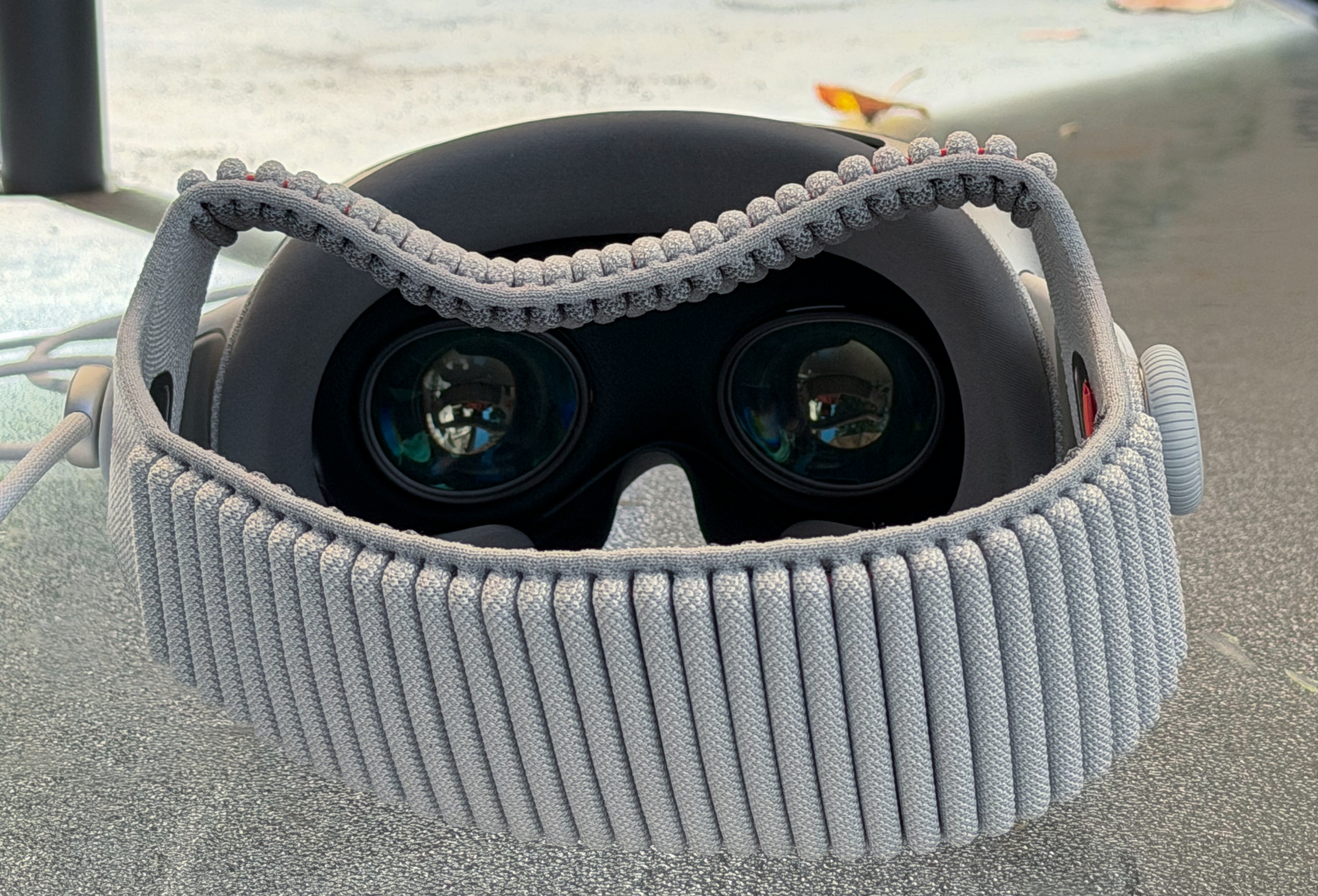
Wrap-up: Still very much a beta
I’m astounded by the Vision Pro every time I put it on. The displays look fantastic, and they’re versatile enough to handle everything from watching movies, immersing myself in 3D content and diving into productivity work by mirroring my MacBook Pro. But, when I take off the headset, reality sets in. It’s still wildly expensive at $3,499, and there isn’t nearly enough spatial computing content to make that price worth it.
Once again, the Vision Pro feels like a proof of concept — a symbol of what Apple can do when it’s not constrained by traditional screens. But the company’s dream of spatial computing won’t go anywhere until it can deliver cheaper devices. As I’ve argued, Apple should just take a cue from Xreal and shove visionOS into a pair of display glasses. That would allow the company to produce a much more accessible device, and it would also put Apple in a better position to compete with Android XR hardware like Samsung’s $1,800 Galaxy XR.
Until Apple can open up visionOS to more users, it will still be just beta testing the future.
This article originally appeared on Engadget at https://www.engadget.com/ar-vr/apple-vision-pro-m5-review-a-better-beta-is-still-a-beta-130000284.html?src=rss
Google’s Pixel 10 Pro Fold is $300 off right now
Somehow it’s already November, which means gift giving season is right around the corner. While Black Friday sales can help with that, there are some great early deals running for anyone who wants to check off their list with time to spare.
Take the Google Pixel 10 Pro Fold, which has only been out since late August. It’s now down to $1,499 from $1,799 — a 17 percent discount. This deal is available at both Amazon and Best Buy, and seems to be the first big markdown on the Pixel 10 Pro Fold. Notably, this deal is on the 256GB model, but the 512GB and 1TB Pixel 10 Pro Folds are also $300 off.
We gave the Google Pixel 10 Pro Fold an 88 in our review, thanks to its improved durability, with an IP68 rating. It also has upgraded software and multitasking, along with Pixelsnap charging. Plus, we found it has the “best cameras of any flexible phone.”
One of our biggest gripes is the price — though this discount certainly helps. It’s also quite a bulky device and can feel pretty heavy.
Follow @EngadgetDeals on X for the latest tech deals and buying advice.
This article originally appeared on Engadget at https://www.engadget.com/deals/googles-pixel-10-pro-fold-is-300-off-right-now-123036704.html?src=rss
You can now buy Anbernic’s budget DS clone, but don’t get your hopes up for 3DS emulation
After teasing its dual-screen gaming handheld last month, Anbernic has already put its RG DS up for preorder on its website. When the Anbernic RG DS was revealed for the first time, the handheld maker only hinted at a price range of less than $100. To Anbernic’s credit, the RG DS starts at $93.99 for preorder pricing and will go up to $99.99 once preorders end.
While Anbernic has kept its pricing promise, the RG DS product page is missing a transparent white colorway that was part of the reveal. Instead, the RG DS is currently only available in three color choices: black & crimson red, turquoise blue and polar white. Perhaps even more disappointing, Anbernic revealed the full specs of the RG DS, which will run on an RK3568 chip. The chip should handle Nintendo DS emulation without a problem, but it will likely struggle to run even the least-intensive 3DS titles. However, Anbernic posted some gameplay demos that show the RG DS running 3DS games like Shovel Knight, Harvest Moon: The Tale of Two Towns and Rune Factory 4.
Besides the chip, the RG DS is built with two four-inch IPS displays that have a 640 x 480 resolution. The twin displays support touch and capacitive stylus input, unlike other dual-screen handhelds. To round out the design, Anbernic included a six-axis gyroscope and a button that switches focus to either display. The Anbernic RG DS will run on Android 14, and you should expect to get roughly six hours of battery life thanks to a 4,000mAh battery. Anbernic said it will start shipping RG DS preorders before December 15.
This article originally appeared on Engadget at https://www.engadget.com/gaming/you-can-now-buy-anbernics-budget-ds-clone-but-dont-get-your-hopes-up-for-3ds-emulation-183140820.html?src=rss
The Google TV Streamer 4K drops to a record low before Black Friday
One of the best streaming devices you can get today is deeply discounted on Amazon ahead of Black Friday. The Google TV Streamer is going for just $75 right now — the lowest price we’ve seen it hit yet. The device normally costs $100. The Amazon deal applies to both color options, White and the soft gray Haze.
The Google TV Streamer is our top pick for an all-in-one streaming device. It has a faster processor than Google’s previous streaming devices (22 percent faster, according to the company), so you can switch between apps and different media without lagging. It also has more storage and memory, at 32GB and 4GB, respectively. Google TV streamer has an intuitive interface and keeps all of your favorite content from different streaming apps organized in one menu. It also seamlessly integrates Google Home, allowing you to control your smart home devices from a slideout panel on the TV.
The 4K streamer comes in a set-top wedge design, rather than the dongle of Chromecasts past, but you’ll have to pick up an HDMI cable separately if you don’t already have one you can use. It comes with a small remote that you can ping by pressing a button on the streamer for when you inevitably misplace it.
In her review of the device, Engadget’s Amy Skorheim called the Google TV streamer “a full-featured, competent device with an interface that’s better than most at pulling together all the disparate threads of a streaming experience.” One of its only downsides is the relatively high cost at $100, so don’t let this deal go to waste.
This article originally appeared on Engadget at https://www.engadget.com/deals/the-google-tv-streamer-4k-drops-to-a-record-low-before-black-friday-173858860.html?src=rss
iOS 26.1 could arrive this week with a toggle to reduce the Liquid Glass effect
All the complaining about the Liquid Glass redesign may have amounted to some real change, since Apple could be offering a compromise with its forthcoming iOS update. According to Bloomberg‘s Mark Gurman, Apple is getting ready to release iOS 26.1, which will have a toggle to reduce the Liquid Glass effect. Gurman said the iOS 26.1 update could roll out to users as early as Monday, while the first beta version of iOS 26.2 should arrive for developers the day after.
Liquid Glass was introduced at WWDC 2025 as Apple’s next big visual overhaul. It didn’t take long for users to test it out and offer up criticisms about the readability and lag caused by the animations. To address these grievances, Apple introduced an option to apply a tinted setting to its transparent redesign in iOS 26.1’s fourth beta.
While the upcoming iOS update won’t introduce anything groundbreaking, Gurman said that the latest update will be “more reliable, with fewer bugs.” Besides the toggle option, iOS 26.1 will have an updated Apple TV icon and other bug fixes, according to Gurman. Looking ahead, Apple is likely to follow the same update pattern as usual, meaning macOS 26.1 and the first beta of watchOS 26.2 should follow.
This article originally appeared on Engadget at https://www.engadget.com/big-tech/ios-261-could-arrive-this-week-with-a-toggle-to-reduce-the-liquid-glass-effect-170451034.html?src=rss
How to use call screening on an iPhone
Spam and scam calls are some of the most annoying things we all have to deal with when it comes to our phones. Apple’s iOS 26 update takes a firm step toward solving this problem with Call Screening, a new feature designed to filter unknown numbers before you ever pick up the phone. Once it’s activated, your iPhone can automatically answer calls from numbers not saved in your contacts, ask the caller to identify themselves and display a real-time transcription of their response on your screen. You can then decide whether the call is worth taking, effectively cutting off spam before it reaches you.
This feature blends convenience and privacy by keeping all processing on the device rather than sending data to the cloud. It’s a logical evolution from earlier tools like Silence Unknown Callers, but this time it allows for a more conversational gatekeeping system that mirrors the experience of live voicemail. Here’s how to turn on Call Screening on your iPhone.
Checking compatibility and updating to iOS 26
Call Screening is available to anyone with an iPhone capable of running iOS 26, which includes models from the iPhone 11 onward. To access it, you first need to make sure your device is running the latest version of the software. You can check this by opening Settings, selecting General and tapping Software Update. If you see that iOS 26 is available, download and install it before continuing.
This step is essential because Call Screening is only available within the redesigned Phone app introduced in iOS 26. Once your device is updated, the feature becomes accessible through the app’s settings menu, ready to be switched on.
How to turn on Call Screening
To enable Call Screening, start by opening the Settings app on your iPhone. Scroll down until you see Apps then tap to open the list and select Phone. Within the Phone settings, look for the section labeled Screen Unknown Callers. This is where you’ll find the new options introduced with iOS 26.
Apple gives you a few choices here. If you select Never, every call will come through as usual, even from numbers that aren’t saved to your contacts. The Ask Reason for Calling option activates the new screening feature, prompting unknown callers to state who they are before you see the transcription on screen. The Silence option, meanwhile, sends unknown numbers directly to voicemail without ringing your phone at all.
To use Call Screening, tap Ask Reason for Calling. Once you back out of the Settings app, the feature will be active. From that point forward, any call from an unfamiliar number will automatically be filtered through Apple’s new screening system.
What Call Screening actually does
When Call Screening is turned on, your iPhone will automatically step in whenever a call arrives from a number it doesn’t recognize. Instead of the phone ringing immediately, the caller hears an automated message that asks them to state their name and reason for calling. Their response is converted into text in real time, which appears on your screen while the call is still active. You can read their answer, assess whether the call looks legitimate and choose whether to pick up or ignore it.
If the call comes from someone in your contacts list, the process doesn’t activate at all, meaning known callers and recent outgoing numbers will continue to ring normally. The feature simply adds a layer of defense between you and unwanted interruptions, allowing genuine callers through while stopping random or suspicious ones before they take your attention.
This article originally appeared on Engadget at https://www.engadget.com/mobile/smartphones/how-to-use-call-screening-on-an-iphone-130041744.html?src=rss
Finally: Thanksgiving Dinner Flavored Oreos
Because occasionally Christmas wishes really do come true 11 months later, Oreo is selling Thanksgiving dinner flavored Oreos. The $20 specialty tin comes with 12 Oreos, with two Oreos each dipped in the following fudge flavors: cranberry sauce, pumpkin pie, creamed corn, caramel apple pie, turkey & stuffing, and sweet potatoes. So, which one do you think is best? And if you answered anything but taking the top off creamed corn and putting it on turkey & stuffing, you’re so wrong I’ll fight you.

